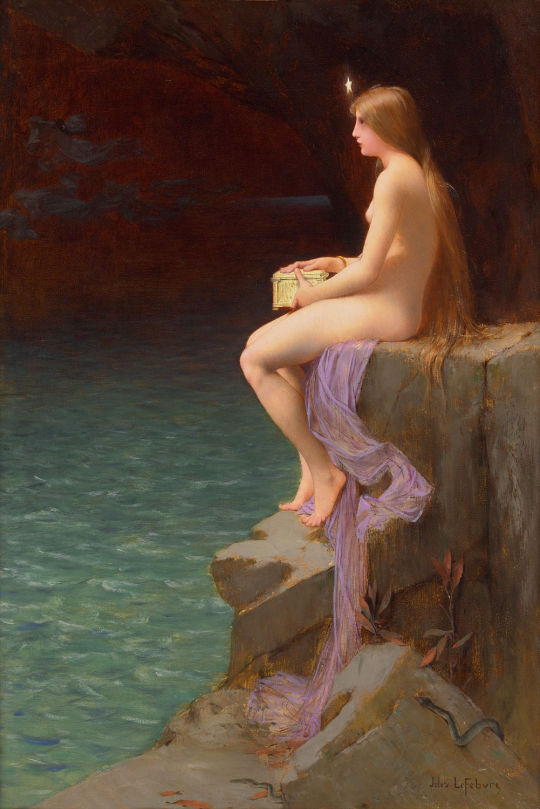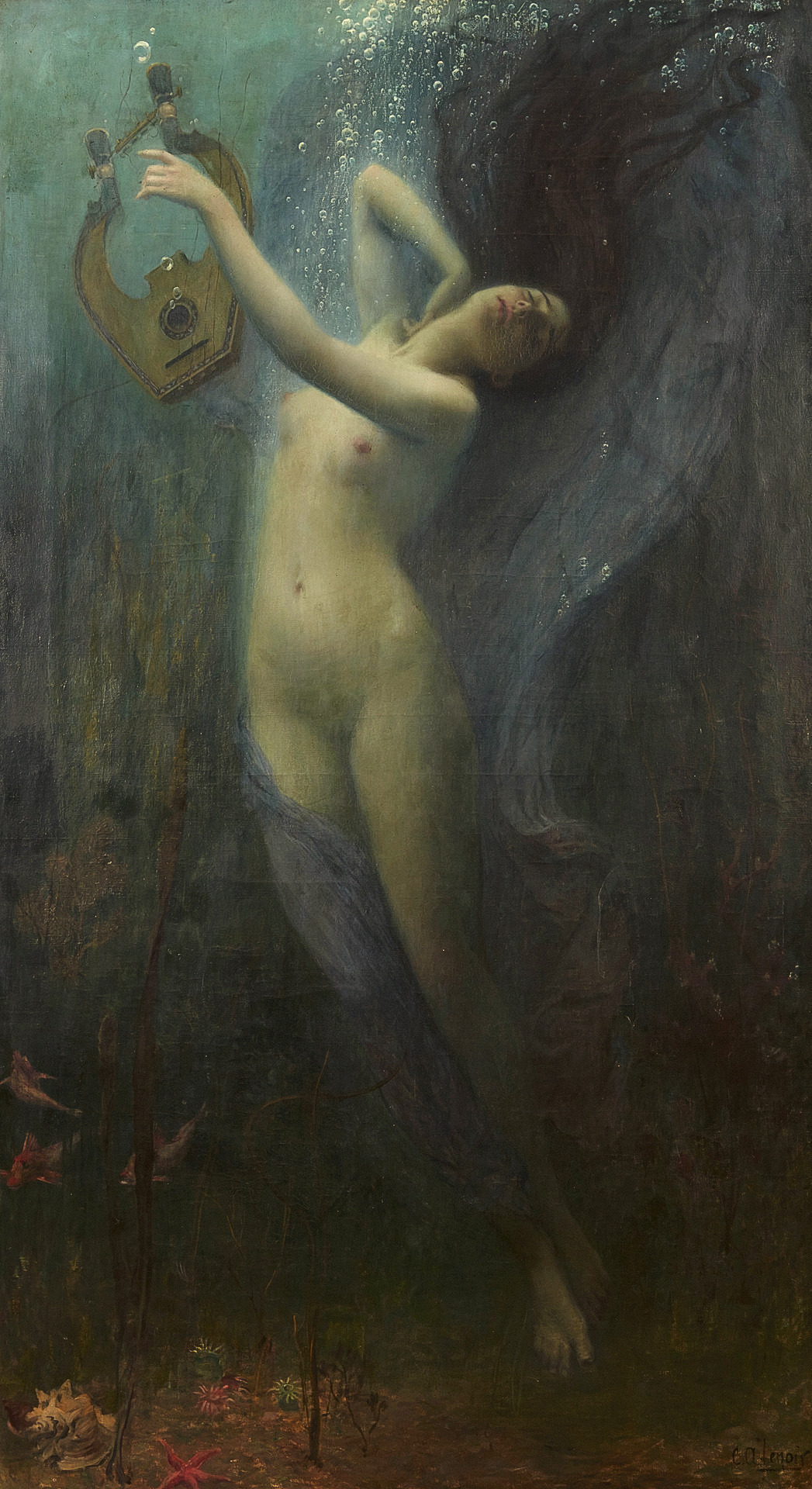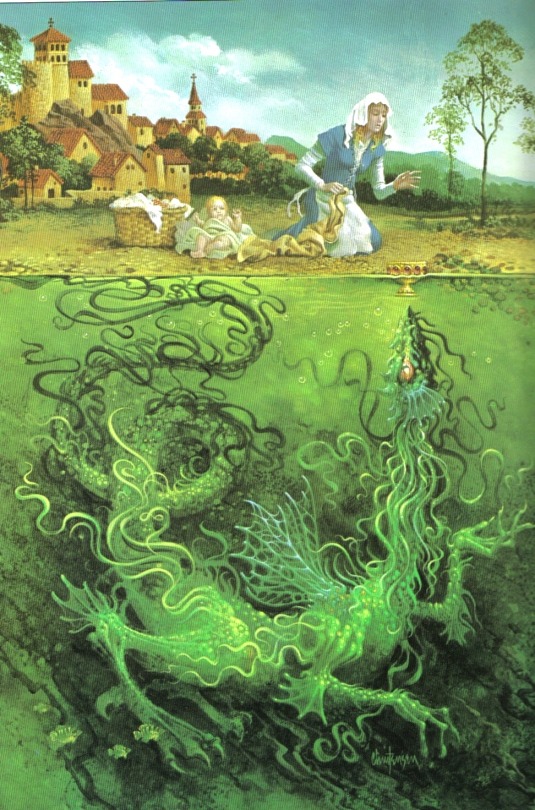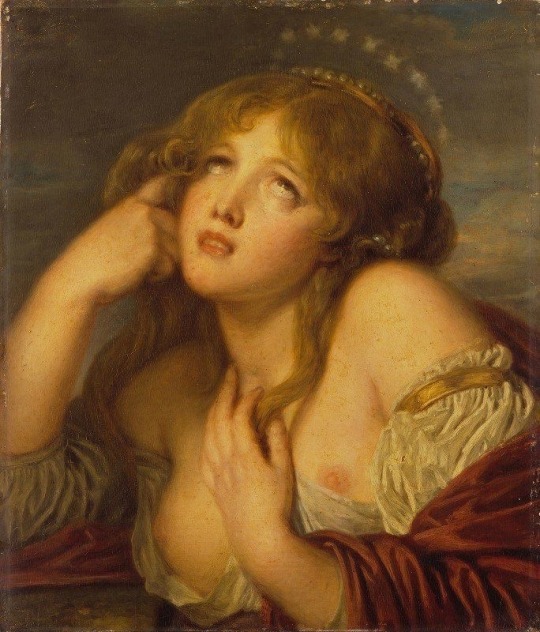#french mythology
Explore tagged Tumblr posts
Photo

Cernunnos by Cahira63
128 notes
·
View notes
Text
The Grand'Goule [medieval French story]

The French former province of Poitou has a local legend about a horrible dragon. The beast made its home in the subterranean corridors underneath the Sainte-Croix abbey, and any nun who ventured there was devoured in an instant.
Named after its giant maw, Grand’Goule had four legs equipped with horribly sharp talons, a pair of wings and a long tail that culminated in a three-pointed stinger. Though details about the appearance of the beast seem to differ. The most famous depiction is a 1677 statue by Jean Gargot (see image).
According to the legend, the beast was eventually slain by Saint Radegonde (which would put the story in the 6th century A.D.), who vanquished the monster by reciting a prayer to it, which banished it to the Clain river. A more recent version has the holy Radegundis stun the beast by making the sign of the holy cross and then throwing a piece of bread in the dragon’s maw that was blessed by a priest. I suspect this story was derived from the practise of throwing baked treats at the wooden dragon at the Rogation procession.
After the dragon was slain, a local woodworker crafted and painted a statue in the likeness of the monster that was stored in the attic of the Sainte-Croix abbey. Every year, the statue was displayed triumphantly at the head of the Rogation procession, as the victory over the beast had become a reason for celebration and festivities among the locals, until Grand’Goule eventually became the main focus of the procession. People would adorn the statue with ribbons and gold, and rub its scales with rosaries while saying ‘Bonne Saint Vermine, pray for us!’ This nickname translates to ‘Good Saint Vermin’.
There is a related story about the abbess Isabeau de Couhé: somewhere in the 1460’s, when a group of clerics claimed that it was against nature that their superior was a woman, Isabeau responded by unfurling a banner with the likeness of the dragon, thereby reminding the clerics that it was a woman who defeated the monster and saved the region.
Supposedly, in 1666, the Palais des Comtes displayed a stuffed crocodile which they claimed was the conserved carcass of the Grand’Goule. According to Lord Fountainhall, the creature was originally much larger than the supposed carcass on display, but it had shrunk throughout the centuries, or so it was claimed.
Sources: Poitevin, F. et al., 2017, Les Contes et Légendes du Poitou, Passeurs de Mémoire, CPE Éditions. Dailey, E.T., 2023, Radegund : The Trials and Triumphs of a Merovingian Queen, Women in Antiquity, Oxford University Press, 213 pp. (image source: statue crafted by Jean Gargot, 1677)
90 notes
·
View notes
Text
Like as a huge mythology nerd I feel like Fate stuff ranges from ‘oh that makes sense’ to ‘that’s crazy but consistent with previous fate plot lines’
Like Medea is an evil witch who performs human sacrifices? Sure that is totally in keeping with the source material.
Astolfo, the most handsome of the Charlemagne’s paladins is actually a ditzy gay twink? Well if you think about it that does work given that it depends entirely on your own sense of what’s handsome or not. Still it’s kinda of weird way to go about it.
King Arthur is really an immortal teenage girl who thinks she’s a failure and wants someone else to pull the sword from the stone? Okay that’s kinda odd but nothing in Welsh Mythology necessarily says Arthur can’t be a woman the Welsh had other women warriors. Personality wise that’s a totally believable place for Arthur to end up.
Mordred is either transgender or at least has a complex about needing to be a man because Arthur is thought of as a man? Well you already made Arthur a woman who is called a ‘king’ so Transgender Mordred actually works really well with the first plot line. Again it’s not beyond the real of possibility historically but it works well because of previous writing choices,
Alexander the Great has a female body double who looks nothing like him? Well we’ve already established that in the fate universe a lot of ancient heroes were really women or trans men so the idea that Alexander’s double is a woman manages to work in context. Besides back before TV and portraits no one actually knew what the king looked like so it’s also not impossible I guess.
#fate stay night#fate series#artoria pendragon#astolfo#fate artoria#fate mordred#celtic mythology#french mythology#greek mythology
29 notes
·
View notes
Text
Does anyone know Paris/French mythology creatures so I can turn them into Spies?
#tf2#tf2 spy#spy tf2#team fortress 2#spy#tf2 oc#tf2 spy oc#teamfortress 2#team fortress2#team fortress#teamfortress2#team fortress 2 spy#team fortess 2#team fortress two#mythical creatures#mythology#french mythology#paris mythology
24 notes
·
View notes
Text
You look upon the Tarrasque

(+ Maxwell for comparison)
#mythology#monsters#tarrasque#dnd#dungeons and dragons#french folklore#french mythology#dragons#dragon#traditional drawing#traditional art
2 notes
·
View notes
Text
youtube
Mystical Figures of French Mythology: A Journey Through Legend and Lore The Secrets of French Mythology
When the veil between worlds thins and shadows dance in the moonlight, the characters of French mythology step out from the bounds of imagination. Are you ready to journey into the darkest recesses of legend, where heroines, fairies, and creatures from a forgotten age unveil their arcane mysteries?
🔍 Discover more in our latest video!
In this video, we will explore:
🌟 La Fée Viviane (The Lady of the Lake): Dive into the crystalline depths of an enchanted lake to meet Viviane, the Lady of the Lake. As the guardian of ancient secrets and mystical powers, she offers gifts of knowledge and magic to those daring enough to meet her piercing gaze.
🌟 Mélusine: Uncover the sorrowful tale of Mélusine, the serpent woman cursed for a secret too dark to reveal. Transforming into a creature of scales under the full moon, her laments tell stories of love and betrayal rooted deep in France.
🌟 Jeanne d'Arc (Joan of Arc): Relive the battles that sculpted France's history with Joan of Arc, guided by mystical visions. This young heroine, a symbol of courage and sacrifice, faced her fate with unwavering faith in an era of darkness.
🌟 La Belle Dame sans Merci: Encounter La Belle Dame sans Merci, an ethereal figure in enchanted woods. She captures hearts only to leave them in despair, her love a sweet poison promising eternity but delivering emptiness.
These guardians of the shadow, these whispers in the night, carry with them the secrets of an age where the line between reality and imagination was a thin mist. French mythology invites us to explore these mysteries, offering a glimpse into an enchanted world that perhaps still lies hidden, just beyond our gaze.
💡 Don't miss the chance to delve into these captivating stories. Watch our video for a journey through the enchanting and mystical world of French mythology!
#Berte aux Grands Pied#Dame Blanche#French Mythology#La Fée Vivian#Mélusine#Mythology#Videos#Youtube
1 note
·
View note
Text

Jules Joseph Lefebvre (1836-1911) "Psyché" Oil on panel Currently in a private collection
#paintings#art#artwork#mythological painting#greek mythology#jules joseph lefebvre#oil on panel#oil on wood panel#fine art#private collection#french artist#psyche#cupid and psyche#female figure#female nude#female portrait#portrait of a woman#long hair#side profile#star#purple#water#a queue work of art#1k#2k#3k#4k
5K notes
·
View notes
Text









The breathtaking splendor of this place is forever engraved in my memory
My photography; Versailles, France, 27 VIII 2023
#art#architecture#art history#Versailles#marie antoinette#original photography#photography on tumblr#photographers on tumblr#olga's diary#my photography#royalcore#princesscore#dark academia aesthetic#places#france#french art#rococo#18th century art#18th century#dark academia#dark academia moodboard#european history#historical art#sculpture#interiors#mythology#light academia#art academia#light academia aesthetic#aesthetic moodboard
2K notes
·
View notes
Text

Danaë by Jean-Baptiste Regnault (18th Century)
#jean-baptiste regnault#art#paintings#fine art#18th century#18th century art#neoclassical#neoclassicism#neoclassical art#painting#french art#french artist#mythology#greek mythology#danae#jupiter#zeus#classic art
8K notes
·
View notes
Text

Charles Amable Lenoir (French, 1860-1926) The Death of Sappho, 1896
#Charles Amable Lenoir#French art#1800s#the death of sappho#art#fine art#european art#classical art#europe#european#fine arts#oil painting#europa#mediterranean#french#france#female nude#classical#painting#greek mythology#mythological art#mythology#arts
5K notes
·
View notes
Text

Epona by Anette Pirso
91 notes
·
View notes
Text

The Drac [French folktales]
The municipality Draguignan in south-east France was originally named Draconeum, and its name was supposedly derived from a local myth about horrible monsters that lived in the nearby river Rhône.
Usually referred to simply as the ‘Drac’, these dragons or dragon-like creatures could shapeshift into the form of a human and walk among the people undetected. They made their homes in underwater caverns along the riverbed and would often shapeshift into golden objects such as cups or rings, in order to attract people. Though they are said to capture children too, their preference goes out to women old enough to lactate.
The drac thus sits beneath the surface of the water in the shape of a desirable golden treasure, enticing women to enter the river. But when they do, the beast grabs them and transports them to its lair where the kidnapped woman is forced to care for the dragon’s offspring as a nurse or maid. These drac caverns aren’t filthy dungeons, rather they are beautiful subterranean palaces. After exactly 7 years of work, the women are usually allowed to return to the world above.
One particular tale tells of a woman who was thus kidnapped and forced to care for young dracs. One day, she accidentally touched her eye with a magical salve or ointment made from eels, after which she gained the ability to see the creatures in their usual, invisible state. But one of the dracs later found out and took this ability away from her.
The story – as described in the 13th century Otia Imperialia – doesn’t tell us what the creatures looked like, however. It is tempting to imagine the dracs as large, scaled reptiles but remember that the word ‘dragon’ was a common umbrella term for evil monsters during this time.
However, these creatures do appear to be reptilian, as the French poet Frédéric Mistral would later describe the dracs as winged reptiles with the head and shoulders of an attractive young man.
Interestingly, the French story of the drac was eventually brought to Great Britain where it gained traction among the Scots and was eventually adapted into Scottish folktales. In this version, the creature was a female fey (in contrast with the French male dragon), but the details of the tale remained the same.
Sources: Tilbury, G., 13th century, Oria Imperialia. I consulted the 1856 version “Des Gervasius von Tilbury Oria Imperialia” by Felix Liebrecht. Holman, F., Valen, N. and Walker, S., 1975, The Drac: French Tales of Demons and Dragons, Scribner, USA, 84 pp. Mistral, F., 1897, Le Poème du Rhône, Paris. Douglas, G., 1901, Scottish Fairy and Folk Tales, 360 pp. (image source: James Christensen)
206 notes
·
View notes
Text

Ariadne
(Jean-Baptiste Greuze, c. 1803-1804).
6K notes
·
View notes
Text
So...
Some of you might already know that I have a huge obsession with mythology. Some of you will already know that in my main blog, I already have a lot of mythology Medic OCs. Today, I am starting to make Mythology Spies OCs soon. And I'll tell you the first French mythology Spies OCs.
These two Spies are actually related. They are half bothers.
The first Spy is a werewolf (his name is Loup) from French mythology, and the second Spy (his name is Louveteau) is based on the Beast of Gévaudan, which I found out is both from French and European mythology.
So BACKSTORY:
It all started with a lady named Benoîte and she was from a rich family. Her family was very strict. But her mother was a nightmare. Her mother would correct everything she did, even the smallest of mistakes.
When Benoîte was growing into an adult. Her mother told her that if she couldn't keep a man while she was pregnant, her mother would consider the baby a monster. When her mother said that, she felt like something went through her. She doesn't know why but it wasn't a good feeling.
She soon met a man who she thought was her true love. A man who shall not be named. The man promised her and her family riches if they got married. The Benoîte family agreed to the man proposal. Soon Benoîte got married to the man, and they soon had a baby boy. While Benoîte was recovering from the pregnancy, the man was secretly stealing the jewelry from her family without her knowing. And he ran away with it. Leaving Benoîte and their child behind.
Benoîte was heartbroken, and her family was disappointed at her. Her and her baby were banished from her family, but they gave her some money. But that was all. She managed to get a small horse in the middle of the woods. One night that was raining harshly with lightning, and she was having a nightmare about what her mother said about considering her baby a monster. But she woke up with a loud sound of lightning, and she slowly stood up when her baby was making noise. But the noise that he was making wasn't normal.
She quickly went to baby crib and screamed in shock. Because her baby boy... was turning into a beast in front of her eyes. She could do nothing but take her baby in her arms and cry for him. Now, the words of her mother weren't just words... But a curse. But that didn't stop her from loving her child. She kept on loving him and taking care of him like he was a normal baby.
A week later, it was night again, and she was trying to put her baby to sleep. But then she heard loud banging outside her door. She was scared who it was, but before she could do anything, the door slammed open. A furry beast came into her house, and she screamed in fear. She tried to pick something to defend herself and her baby. But the werewolf raised her hand and spoke.
"Please! I mean no harm! I'm sorry for breaking your door! But would you let me in if I even knocked?!" Asked the female werewolf. Benoîte slowly calmed down, but she still held her guard up.
"W-Who are you?! WHAT are you?!" Benoîte yelled at the werewolf.
"My name is Neige. And I am a werewolf. I thought that was easy to tell. But that doesn't matter! I came here because I heard a man I used to be had another child." Neige explained to Benoîte.
"What...?" Benoîte asked confusedly.
Neige sighed deeply and spoke again, "When I was in a human form in a day, I used to like to go to bars to drink all day to drown my worries. And that was when I met him."
Neige took out a picture of the man she managed to get and showed Benoîte the picture. Benoîte gasped when she saw the picture. It was the same man who left her and her baby.
"I guess you know him. You see... I was very drunk. He and I... Let's say "did it" together, and I thought nothing about it. But then, I found out that I was pregnant and I tried to find him but I couldn't. It's like he disappeared. But I didn't want to risk the life of my baby. So... I took care of my child all by myself." Neige said in a very sad tone, and she looked at Benoîte.
"But then... I heard rumors that the same man got married but left a woman with her baby all alone. And I wanted to find out who that woman was. And it was you." Neige explained even more, and she showed her baby to Benoîte. Neige baby was very hairy with pointy ears.
Benoîte looked at the baby and looked at Neige.
"How did you manage to find me? And... Why?" Benoîte asked while still holding her own baby.
"I asked around... and I pretend to be close to you. AND! The reason I wanted to find you is because I want us to help each other. And I want our babies to know that they aren't alone. I know all of this is crazy. But I am willing to help you." Neige said.
Benoîte looked like she was thinking really hard, and soon, she sat on her bed still holding her baby. She made a small smile and looked at Neige.
"What's your baby name?" Benoîte asked with a sweet smile.
Neige slowly made a soft smile and said, "His name is Loup. What's your baby name?"
"His name is Louveteau."
(Sorry if this is too long and cringy. But... You know what they say. Be cringe. Be free.)
#tf2#tf2 spy#spy tf2#team fortress 2#spy#tf2 spy oc#tf2 oc#mythology#french mythology#European mythology#mythology oc#werewolf oc#werewolf#beast of gevaudan#beast of Gévaudan#beast of Gévaudan oc#wolf oc#wolves oc
12 notes
·
View notes
Text

The Mermaid Pl 3, 1911 Edmund Dulac
Mermaid Mondays
#Edmund Dulac#french art#1910s#art#painting#art history#story#fairy tale#mythology#mermaid#illustration
2K notes
·
View notes
Text

Gustave Doré (French, 1832-1883) - Sir Lancelot Approaching the Castle of Astolat
969 notes
·
View notes